Hair loss affects millions of men and women worldwide, often leading to a decline in confidence and self-esteem. While modern treatments provide many solutions, one of the most established surgical methods for achieving fuller hair is the strip hair transplant, also known as Follicular Unit Transplantation (FUT). This technique has been widely used for decades and remains a reliable choice for those seeking long-lasting results.
For individuals considering a hair transplant in Raleigh or anywhere else, understanding how strip hair transplants work, their benefits, potential drawbacks, and recovery process is essential before making a decision.
What Is a Strip Hair Transplant?
A strip hair transplant, or FUT, is a surgical hair restoration procedure where a strip of skin containing healthy hair follicles is removed from the donor area (usually the back or sides of the scalp). These follicles are then transplanted into areas affected by thinning or baldness.
Unlike some non-surgical options, FUT provides permanent results because the transplanted follicles are resistant to hair loss hormones.
The Procedure Explained
Patients interested in a hair transplant in Raleigh can expect the strip method to involve several key steps:
1. Preparation and Anaesthesia
The donor and recipient areas are prepared, and local anaesthesia is administered to ensure patient comfort throughout the procedure.
2. Removal of the Donor Strip
A thin strip of scalp tissue is surgically removed from the donor area. The incision is then carefully closed with sutures, leaving behind a fine linear scar that is usually concealed by surrounding hair.
3. Follicle Dissection
The strip is placed under a microscope, where skilled technicians divide it into natural follicular units. Each unit typically contains one to four hairs, ensuring a natural appearance when transplanted.
4. Graft Placement
Tiny incisions are made in the recipient area, and the prepared grafts are implanted with precision to mimic the natural direction and pattern of hair growth.
5. Recovery and Healing
The donor site heals within a few weeks, and the transplanted follicles enter a resting phase before beginning to grow new hair after about three to four months. Full results typically appear within nine to twelve months.
Why Choose a Strip Hair Transplant?
The FUT technique offers several advantages over other methods, making it an appealing choice for many patients:
- High Graft Yield – FUT often provides a larger number of grafts in a single session compared to FUE (Follicular Unit Extraction), making it suitable for patients needing extensive coverage.
- Cost-Effective – Because more grafts can be harvested at once, the overall hair transplant cost may be lower compared to multiple smaller FUE sessions.
- Natural Results – The use of follicular units ensures a natural-looking hairline and density.
- Established Technique – FUT has a long history of success, with decades of clinical data supporting its effectiveness.
How FUT Differs From Other Methods
Many patients deciding between FUT and FUE often ask about the main differences:
- Donor Area – FUT involves removing a strip, while FUE extracts individual follicles.
- Scarring – FUT leaves a linear scar, whereas FUE leaves tiny dot-like scars. Both can be concealed under hair.
- Procedure Time – FUT sessions may be quicker since grafts are extracted all at once.
- Healing – FUE may offer a slightly faster healing process, but FUT remains efficient for larger sessions.
Both techniques have their place, and the choice depends on hair loss patterns, desired results, and personal preference.
Recovery and Aftercare
Recovery from a strip hair transplant is straightforward, though patients should follow aftercare guidelines closely:
- Initial Healing – Sutures are usually removed after 7–14 days. Mild discomfort or tightness in the donor area is normal.
- Hair Shedding – Transplanted hairs often shed within the first few weeks. This is temporary, as new growth begins within three to four months.
- Activity Restrictions – Strenuous exercise should be avoided for at least two weeks to prevent strain on the healing donor site.
- Final Results – By the one-year mark, patients typically see significant improvement in density and overall hair thickness.
Who Is a Good Candidate for a Strip Hair Transplant?
A strip hair transplant may be recommended if:
- You have moderate to severe hair loss and require a large number of grafts.
- You have good scalp laxity (flexibility), which makes removing the strip easier.
- You don’t mind a fine linear scar that can be hidden by hair.
- You want a cost-effective option with proven long-term results.
Patients in Raleigh considering hair restoration should consult with a qualified surgeon to determine whether FUT, FUE, or a combination of both is best suited for their situation.
Hair Transplant Cost Considerations
The hair transplant cost can vary depending on the number of grafts required, the complexity of the case, and the experience of the surgeon. FUT generally costs less per graft compared to FUE, which is why some patients choose it for large-scale transplants.
Patients seeking a hair transplant in Raleigh should schedule a consultation with a reputable clinic to receive a tailored cost estimate.
Final Thoughts
A strip hair transplant is a time-tested and effective procedure for restoring thicker hair, particularly in individuals with significant hair loss. While it differs from newer methods like FUE, FUT remains an excellent choice for patients seeking dense coverage in a single session.
For those exploring hair transplant in Raleigh options, consulting with an experienced surgeon will help determine if FUT is the right solution. With proper planning, aftercare, and realistic expectations, a strip hair transplant can restore not just hair but also long-term confidence and self-image.
